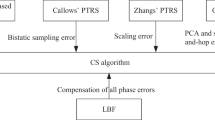Abstract
Considering the difficult transceiver-isolation problem of the monostatic synthetic aperture radar (SAR) in the terahertz (THz) band, this paper proposes a compact THz bistatic SAR (BiSAR) geometry. The system allows the separately distributed transmitter and receivers. At the receiving end, there are a direct-wave receiver and an echo receiver, both operating at the heterodyne and in-phase mode. The echo receiver runs along a linear rail to fulfill the scene scanning, while the direct-wave one is fixed as a reference. Furthermore, assuming that the receivers are synchronized, both the problem of synchronization between the separated transmitter and receivers and the problem of timing at the signal acquisition would be solved by utilizing the high coherence between the echo and the direct wave. Based on such a system, the application of THz BiSAR for one-dimensional imaging is taken into consideration. Then, a high-resolution imaging algorithm is proposed benefitting from the total least squares estimating signal parameters via rotational invariance techniques (TLS-ESPRIT) and the spatial smoothing process (SSP). The imaging performance is then demonstrated by both simulations and the experiments in the 0.183 THz.






Similar content being viewed by others
References
Liu H. B., Zhong H., Karpowicz N., et al., Terahertz spectroscopy and imaging for defense and security applications. Proceedings of the IEEE 95(8): 1514–1527 (2007).
Catapano I, Soldovieri F, Mazzola L, et al., THz Imaging as a method to detect Defects of aeronautical coatings. Journal of Infrared, Millimeter, and Terahertz Waves : 1–14 (2017).
Ouchi T., Kajiki K., Koizumi T., et al., Terahertz imaging system for medical applications and related high efficiency terahertz devices. Journal of Infrared, Millimeter, and Terahertz Waves 35(1): 118–130 (2014).
Flammini, Mariano, et al., Confocal terahertz imaging of ancient manuscripts. Journal of Infrared, Millimeter, and Terahertz Waves 38.4: 435–442 (2017).
Ni J., Zhang Q., Yang Q., et al., Directional feature: a novel feature for group target detection in high resolution SAR images. Remote Sensing Letters 8(8): 713–722 (2017).
Liu G., Guo H., Yue H., et al., Modified four-pass differential SAR interferometry for estimating mountain glacier surface velocity fields. Remote Sensing Letters 7(1): 1–10 (2016).
Jackson J. A., Moses R. L., Feature extraction algorithm for 3D scene modeling and visualization using monostatic SAR. Defense and Security Symposium. International Society for Optics and Photonics: 623708-623708-12 (2006).
Wang R., Deng Y. K., Loffeld O., et al., Processing the azimuth-variant bistatic SAR data by using monostatic imaging algorithms based on two-dimensional principle of stationary phase. IEEE Transactions on Geoscience and Remote Sensing 49(10): 3504–3520 (2011).
Hu K., Zhang X., Shi J., et al., Image reconstruction method for stepped-frequency multichannel bistatic SAR. Remote Sensing Letters 8(1): 48–57 (2017).
Walterscheid I., Ender J., Brenner A. R., et al., Bistatic SAR processing and experiments. IEEE Transactions on Geoscience and Remote Sensing 44(10): 2710–2717 (2006).
Cherniakov M., Zeng T., Plakidis E., Ambiguity function for bistatic SAR and its application in SS-BSAR performance analysis. Radar Conference, 2003. Proceedings of the International. IEEE: 343—348 (2003).
Klare J., Walterscheid I., Brenner A., et al., Evaluation and optimisation of configurations of a hybrid bistatic SAR experiment between TerraSAR-X and PAMIR. Geoscience and Remote Sensing Symposium, 2006. IGARSS 2006. IEEE International Conference on. IEEE: 1208—1211 (2006).
Moccia A., Rufino G., De Luca M., Oceanographic applications of spaceborne bistatic SAR. Geoscience and Remote Sensing Symposium, 2003. IGARSS’03. Proceedings. 2003 IEEE International. IEEE: 1452—1454 (2003).
Hong F., Wang R., Zhang Z., et al., Integrated time and phase synchronization strategy for a multichannel spaceborne-stationary bistatic SAR system. Remote Sensing 8(8): 628 (2016).
Lombardi M. A., Nelson L. M., Novick A. N., et al., Time and frequency measurements using the global positioning system. Cal Lab: International Journal of Metrology 8(3): 26—33 (2001).
Zhang M., Wang R., Deng Y., et al., A synchronization algorithm for spaceborne/stationary BiSAR imaging based on contrast optimization with direct signal from radar satellite. IEEE Transactions on Geoscience and Remote Sensing 54(4): 1977-1989 (2016).
Sheen D. M., McMakin D. L., Hall T. E., Three-dimensional millimeter-wave imaging for concealed weapon detection. IEEE Transactions on microwave theory and techniques 49(9): 581—1592 (2001).
Zhang S., Zhang Y., Wang W. Q., et al., Sparsity-inducing super-resolution passive radar imaging with illuminators of opportunity. Remote Sensing 8(11): 929 (2016).
Yang T., Wang Y., Chen G., Digital beamforming in elevation for spaceborne HRWS SAR based on sparse DOA estimation. Remote Sensing Letters 8(5): 448—457 (2017).
Acknowledgements
This work was supported in part by the National Program on Key Basic Research Project of China (973 Program) (2014CB339806), the Major National Development Project of Scientific Instrument and Equipment (2012YQ15009205, 2016YFC1202505), National Natural Science Foundation of China (61605113), the Natural Science Foundation of Shanghai (16ZR1423100), Shanghai leading talent (2016-019), and Young Yangtse Rive Scholar.
Author information
Authors and Affiliations
Corresponding author
Additional information
Li Ding and Yangyang Ye contributed equally to this work.
Rights and permissions
About this article
Cite this article
Ding, L., Ye, Y., Ye, G. et al. Terahertz Bistatic Synthetic Aperture Radar for 1-D Near-Field High-Resolution Imaging. J Infrared Milli Terahz Waves 39, 1162–1173 (2018). https://doi.org/10.1007/s10762-018-0530-2
Received:
Accepted:
Published:
Issue Date:
DOI: https://doi.org/10.1007/s10762-018-0530-2




